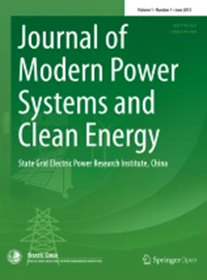Communication-Aware Restoration of Smart Distribution Grids Based on Optimal Allocation of Resilience Resources
IF 6.1
1区 工程技术
Q1 ENGINEERING, ELECTRICAL & ELECTRONIC
Journal of Modern Power Systems and Clean Energy
Pub Date : 2024-10-04
DOI:10.35833/MPCE.2024.000015
引用次数: 0
Abstract
Although power grids have become safer with increased situational awareness, major extreme events still pose reliability and resilience challenges, primarily at the distribution level, due to increased vulnerabilities and limited recovery resources. Information and communication technologies (ICIs) have introduced new vulnerabilities that have been widely investigated in previous studies. These vulnerabilities include remote device failures, communication channel disturbances, and cyber-attacks. However, only few studies have explored the opportunity offered by communications to improve the resilience of pow-er grids and eliminate the notion that power-telecom interdepen-dencies always pose a threat. This paper proposes a communication-aware restoration approach of smart distribution grids, which leverages power-telecom interdependencies to determine the optimal restoration strategies. The states of grid-energized telecom points are tracked to provide the best restoration actions, which are enabled through the resilience resources of re-pair, manual switching, remote reconfiguration, and distributed generators. As the telecom network coordinates the allocation of these resilience resources based on their coupling tendencies, different telecom architectures have been introduced to investigate the contribution of private and public ICTs to grid management and restoration operations. System restoration uses the configuration that follows a remote fast response as the input to formulate the problem as mixed-integer linear programming. Results from numerical simulations reveal an enhanced restoration process derived from telecom-aware recovery and the co-optimization of resilience resources. The existing disparity between overhead and underground power line configurations is also quantified.基于弹性资源优化配置的智能配电网通信感知恢复
尽管随着态势感知能力的提高,电网变得更加安全,但由于脆弱性增加和恢复资源有限,主要在配电层面,重大极端事件仍然对可靠性和弹性构成挑战。信息和通信技术(ICIs)引入了新的漏洞,这些漏洞在以前的研究中得到了广泛的研究。这些漏洞包括远程设备故障、通信信道干扰和网络攻击。然而,只有少数研究探索了通信提供的机会,以提高电网的弹性,并消除电力-电信相互依赖总是构成威胁的观念。本文提出了一种基于通信感知的智能配电网恢复方法,该方法利用电力-电信相互依赖关系来确定最优恢复策略。通过修复、手动切换、远程重新配置和分布式发电机等弹性资源,跟踪并网电信点的状态,以提供最佳的恢复行动。由于电信网络根据其耦合趋势协调这些弹性资源的分配,因此引入了不同的电信架构来研究私有和公共ict对网格管理和恢复操作的贡献。系统恢复使用遵循远程快速响应的配置作为输入,将问题表述为混合整数线性规划。数值模拟结果表明,电信感知恢复和弹性资源的协同优化增强了恢复过程。同时对架空和地下电力线配置之间存在的差异进行了量化。
本文章由计算机程序翻译,如有差异,请以英文原文为准。
求助全文
约1分钟内获得全文
求助全文
来源期刊

Journal of Modern Power Systems and Clean Energy
ENGINEERING, ELECTRICAL & ELECTRONIC-
CiteScore
12.30
自引率
14.30%
发文量
97
审稿时长
13 weeks
期刊介绍:
Journal of Modern Power Systems and Clean Energy (MPCE), commencing from June, 2013, is a newly established, peer-reviewed and quarterly published journal in English. It is the first international power engineering journal originated in mainland China. MPCE publishes original papers, short letters and review articles in the field of modern power systems with focus on smart grid technology and renewable energy integration, etc.
 求助内容:
求助内容: 应助结果提醒方式:
应助结果提醒方式:


